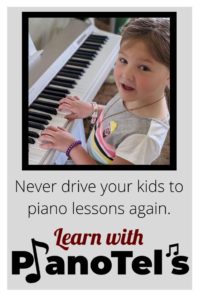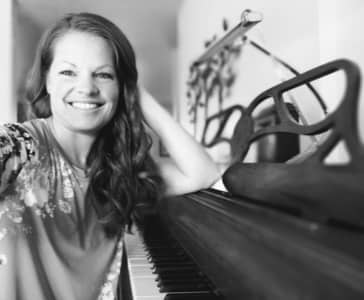With a million different methods to learn how to read music, why would I choose relativity as my favorite way of teaching beginners to play the piano? This is one of the quickest and easiest ways to remember how to read music in order to play the piano.
What does it mean to teach piano notes to beginners using relativity? Using relativity in note reading, is to learn a note on the scale and find out where it matches up on the piano keyboard. Then, using steps and skips, you can find the other notes on the keyboard relative to the original note learned.
Traditionally, beginning student’s will be given a piece of music to follow using only their finger numbers for guidelines. While this does work, I find it most effective to start reading music, truly reading music, from the very beginning — from lesson #1.

The Quick Explanation of Teaching Piano with Relativity
Using relativity is simple. You find a couple notes on the keyboard that match up to notes on the staff. I like to use the bottom, middle, and top lines, E, B, and F on the treble clef. But really you can use whatever notes you would like. You can find any note once you know where these notes are on the piano by using relativity. Every note is either a step or a skip relative to these notes. So when you are trying to identify a D, you think, “That’s one step down from an E.” Or if you see a G on the staff and aren’t sure where it is on the keyboard, you count how many steps or skips (a skip being two steps) up that note is from the E that you do know.
I teach the bass clef using the same method. Really memorize a few notes on the staff that match up to the keyboard, and you can then use steps and skips to find the other notes.
Eventually, with enough practice, all of the notes will become familiar to the student and there won’t be as much thinking but more just playing due to previous experience and recognition.
The Full Explanation of Teaching Piano with Relativity
Staff Awareness: Steps
If we look at a staff, it has five lines and four spaces. Each line and space represent a step up or a step down depending on if you are going up the staff or down the staff. I like to demonstrate the idea of a staff on a large blanket that I have taped across with masking tape to make five lines. Or, if you are willing to buy a rug, this one is awesome.
Have the students get on the blanket or rug on the floor and step up and down the staff. Take STEPS — from a line to a space or a space to a line. Then, I walk over to the piano and show each step on the piano going up or going down. When I “step” up on the piano, they “step” up on the staff. When I “step” down on the piano, they “step” down.
Then, I put a large black oval on the bottom line of the staff, an E if we are in treble clef. Then, we find that note on the keyboard. That note on the bottom line is represents where the note lives on the piano — an E. Make sure they get this down.
Teach other notes relative to an E
Now you can teach using relativity. Step up from the E on the piano, step up on the staff. Because it is one step up on the staff, you go one step up on the keyboard. Voila — now you have an F. You can do the same thing with a G. I reinforce the learning here by having them describe each key relative to an E. For example, an F is one step away from an E. G is two steps up from an E, or a skip up.
I take a quick break here to assess the student to make sure that they get this idea. We leave the staff and sit down at the piano. I pull out flash cards for E, F, and G. As I show them, they play the keys on the piano.
More Staff Awareness — D and C
Your student may or may not be aware that the notes can “run off” the staff and continue on, even though it is out of lines and spaces. You can demonstrate how this work as the student steps off the staff.
At this point, you can then show the student how these notes are relative to an E. They are steps down from the E. One step down is a D. Another step down is a C.
Practice, Practice, Practice
 At this point, they now know 5 notes on the keyboard, relative to E. There are a lot of beginning method books that this student can begin to practice certain songs on. They can usually skip a lot of the beginning material and go straight to the playing of the music. I love the fact that they skip so many of the material previous to this because they can immediately begin to play more “advanced” songs and not be stuck with something so boring. They love playing “real” songs. And I love to hear them too.
At this point, they now know 5 notes on the keyboard, relative to E. There are a lot of beginning method books that this student can begin to practice certain songs on. They can usually skip a lot of the beginning material and go straight to the playing of the music. I love the fact that they skip so many of the material previous to this because they can immediately begin to play more “advanced” songs and not be stuck with something so boring. They love playing “real” songs. And I love to hear them too.

Bass Clef
Teaching the bass clef is just patterning what you did with the treble clef. Choose several notes to teach relative to. I like to choose the bottom, middle, and top lines of the notes. But you can do as you wish.
As a note: I do like to teach notes that are more relevant to what they will be playing. I save some of the other notes until they learn these ones well first. No need to bombard them with so much information they can’t retain it all. Judge the student to how much information would be healthy and good for them and stop where it is appropriate.
What about all the other stuff?
So if you do skip some material in your method books — sometimes even skipping the whole “primer” level , then you will need to introduce some of the more technical terms of piano as they continue to play. To me, I find that a little more dry and harder to pick up, unless it becomes immediately relevant to the student because it is in the music that they are playing. So the order in which I teach, goes something like this:
- Staff awareness — lines and spaces, steps and skips
- Keyboard awareness — steps and skips
- E on the treble clef to the keyboard
- C,D,F,G relative to E
- Bass clef — D on the staff to the keyboard
- C,E,F,G relative to D
At this point, they can begin to play most level 1 music. Then, after a week or two of practice, I begin to teach other concepts:
- Measures including bar lines, double bar lines
- Notes: quarter, eighth, half, dotted half, whole
- Rests
- Time signatures
- Ties, slurs, repeats, etc. as they come up in the music
From there, you follow along with the method book to make sure you catch all the rest of the musical terms, etc.
The Best Way
You may have a reason to argue, but in the years of teaching different methods, I have found this to be the most full-proof, quickest and easiest way to learn how to read music. The students catch on so fast this way. They avoid getting bogged down with terminologies that distract them from actually getting the fingers to the keys. Those terminologies come with time, but not until the student is well on their way to playing songs fairly proficiently.
Tel loves her life as a piano player, a piano teacher, and a mom. Amid piano blogging, piano teaching, and piano playing, she loves a chance to fit in a good exercise class, volunteer at her kids’ school and at her church, and go on long dates with her husband. Full bio at About Tel.


